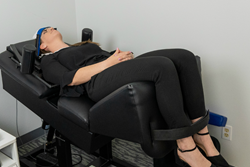
Patient using spinal decompression therapy
As soon we explain the goal of the spinal decompression therapy, patients always say ‘oh, that sounds great. I want to do that.’ – Dr. Natalie Cordova
HOUSTON (PRWEB)
September 22, 2020
According to Drs. Natalie and Philip Cordova at CORE Chiropractic, spinal decompression therapy is a successful therapy for patients experiencing chronic neck and back pain. Patients with pain due to bulging or herniated discs, facet syndrome, degenerative disc disease, or a failed back surgery are the best candidates for this therapy.
“The Back on Trac tables are different than other spinal decompression tables because they do not have any scary restraints or belts,” says Dr. Natalie Cordova, “our patients can get into the machine and start therapy in about 30 seconds.” In the past, the decompression therapy tables were monstrous, almost filling up an entire room.
Patients were often apprehensive about attempting to use the machine unless their condition was severe. The tables were also very expensive, and that meant patients paid hundreds of dollars per visit to receive the treatment. Treatment was effective, but often uncomfortable to both set up and while receiving treatment.
All patients require an initial assessment and spinal x-rays prior to starting the therapy. “We have to make sure there’s nothing going on in the patient’s spine that would stop us from decompressing their spine. The Back on Trac table has 21 different protocols, which allows us to safely and comfortably perform the treatment for almost any patient. We just need to make sure we know which protocol will be the best option,” said Dr. Philip Cordova.
If you tell someone you can pull up to six inches on their spine, would that be a bad thing? No one seems to think so. Dr. Natalie Cordova tells us, “As soon we explain the goal of the spinal decompression therapy, patients always say ‘oh, that sounds great. I want to do that.'”
Spinal decompression therapy is a type of motorized traction that consists of gentle stretching of the spinal column. Depending on the protocol used, the machine will pull, then return about 25% – 50%, and then pull again. This pumping action helps provide vital nutrients and fluids back into the spinal disc. Over time, the stress release from decompression treatment may result in the reversal of bulging or herniated discs and prevention of a dependency on drugs or the need for surgery.
“Our goal is on both acute pain relief and to be a part of ongoing wellness care,” said Dr. Philip Cordova. “We’ve already seen great results with our patients. X-rays taken a few months later have also shown measurable changes.”
After just one session patients often report initial pain relief. After a series of treatments, patients report the relief lasts longer. Ongoing care and period decompression sessions can be helpful in preventing further spinal degeneration and the cumulative damage that comes from sitting for long periods of time. Spinal decompression therapy can be performed on the neck (cervical spine) and the low back (lumbar spine).
Share article on social media or email:
